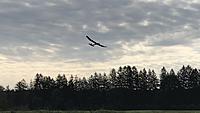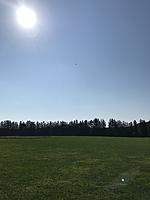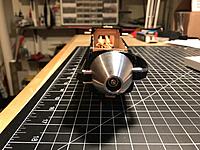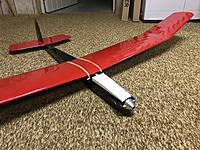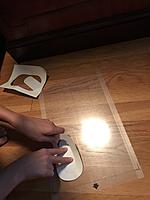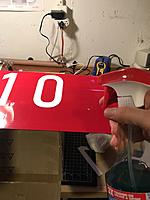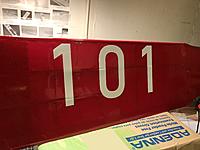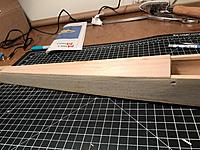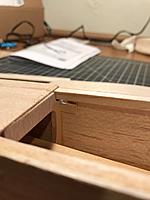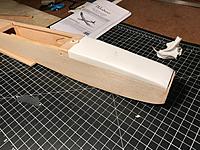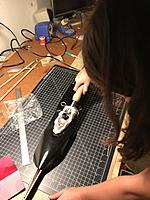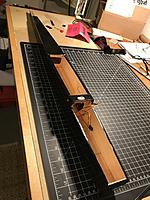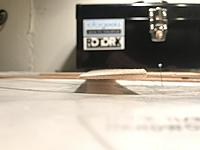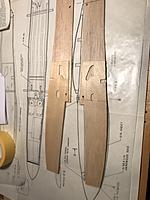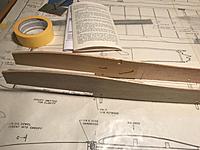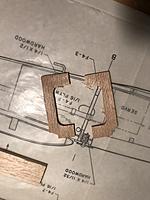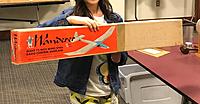Comments (0)
Add Comment
-
Views: 126
Underside of the inner panel is covered. -
Views: 132
I'm happy with the results of covering the wing tips. I was afraid it would be difficult and turn out badly, but after watching a couple of YouTube videos, I did just fine. -
Views: 138
Introducing washout. -
 Views: 142
Views: 142
All done. -
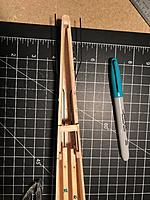 Views: 134
Views: 134
Getting the wire ends of the push rods bent into the right positions. -
Views: 124
After soldering on clevises. What do you know, a perfectly flat elevator on the first try! Not so lucky with the rudder, but I had enough thread available on the servo side clevis to get the rudder straight without having to re-solder. -
Views: 127
Checking that the horizontal stab is level to the wings. Really looks like a plane now.
-
 Views: 131
Views: 131
Getting ready to put the first bit of covering on this project. -
Views: 156
Bottom completed. -
 Views: 129
Views: 129
The top covering wrapped around the edges to overlap on the bottom about 1/8". I watched some videos about stretching the Monokote around the curves, and It wasn't too bad. -
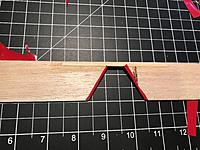 Views: 120
Views: 120
I figured that covering these edges of the elevator at the same time as the broad surfaces would be tricky, so I covered them first. -
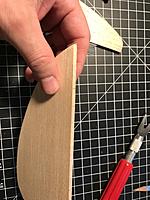 Views: 133
Views: 133
Marking the rudder for hinges. I haven't yet sanded the taper into the rudder or rounded the edges. I wanted nice square flat surfaces for aligning the hinge slots. -
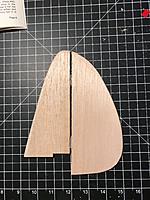 Views: 132
Views: 132
Rudder has been tapered and edges shaped to profile. -
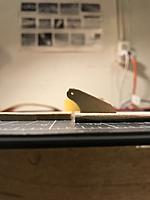 Views: 129
Views: 129
Aligning the rudder control horn to the hinge axis. -
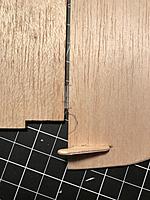 Views: 144
Views: 144
A notch needed to be cut out of the rudder to prevent it binding against the rod connecting the elevator halves.
-
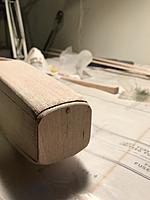 Views: 143
Views: 143
Test fitting the canopy. Note the dowel that is glued into the canopy, and fits in the hole in the firewall. The dowel was later sanded flush. -
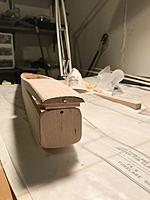 Views: 124
Views: 124
Showing one of the horizontal rods that registers the canopy position left-right in the fuse. -
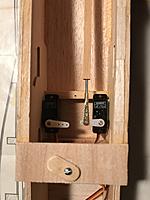 Views: 137
Views: 137
Servos in place. Test fitting the push rod. Here also you can see the rotating tab that spins to lock the tail-end of the canopy down. -
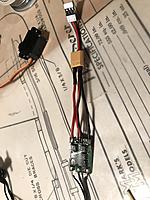 Views: 123
Views: 123
Brand new wires on a used ESC. -
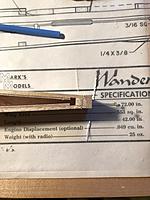 Views: 130
Views: 130
Adding the tail post. -
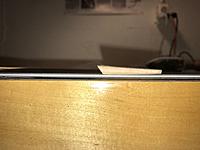 Views: 120
Views: 120
-
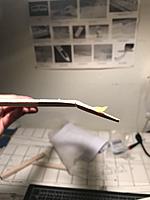 Views: 125
Views: 125
-
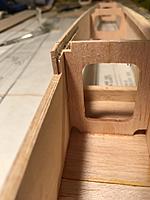 Views: 144
Views: 144
I notched the upside-down bulkhead to make room for the wing supports. -
 Views: 139
Views: 139
Wing supports being glued in. -
 Views: 140
Views: 140
Adding the bottom sheet. -
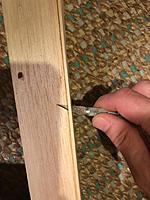 Views: 133
Views: 133
Paring away the excess sheet before sanding. Holes for wing dowels are drilled. -
 Views: 146
Views: 146
Rough cutting the firewall on a scroll saw. Then sanded to exact shape. -
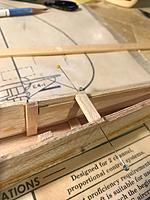 Views: 132
Views: 132
-
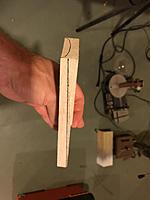 Views: 149
Views: 149
-
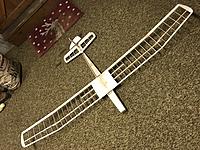 Views: 143
Views: 143
-
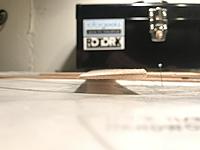 Views: 123
Views: 123
Tapered elevator. -
 Views: 134
Views: 134
You can see that the former in the foreground is upside down. The former in the rear is properly oriented. -
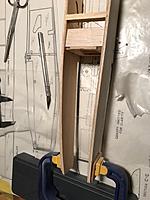 Views: 139
Views: 139
Whoops. Was supposed to have clamped the nose and glued the front-most former in. Getting ready to do it now. Note the tow hook block is installed, and a brace is pinned behind the 2nd former so it won't buckle under the clamping pressure. -
Views: 123
Dampening the tops of the 3/16" balsa sheet gave it a bit of a curve. -
Views: 140
It took a lot of pins to hold the sheeting down tight while the glue dried. But after the wet balsa dried, small gaps opened between the sheets. -
Views: 125
Gaps are filled with a putty of sawdust and wood glue, and are being sanded to shape. Note the front-most former is now properly in place.
-
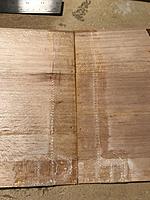 Views: 126
Views: 126
Might revisit the epoxy mess at the bottom to see if I can smooth it out without cutting into the fiberglass. -
Views: 143
-
Views: 114
Test fitting all the balsa bits for the tail. -
 Views: 120
Views: 120
Shaping these square supports was a pain. Very light sanding of the end for length produces a very dramatic shift in the horizontal positioning. -
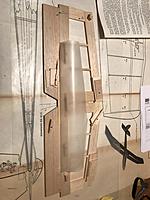 Views: 125
Views: 125
Glueing it all up. As per instructions I glued the hardwood elevator "joiner" with the elevator in place. I snugged it up to the trailing edge of the stab to keep it straight. Wax paper prevented any glue squeeze-out from gluing the elevator to -
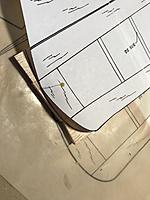 Views: 125
Views: 125
I printed a full size copy of the plans and cutout the stabilizer to transfer the shape to the balsa. -
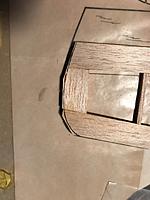 Views: 123
Views: 123
I rough-cut the shape with a saw, brought it even closer with an electric disk sander, and finished it to shape by hand. -
 Views: 133
Views: 133
Not bad...
-
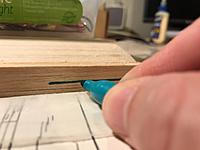 Views: 141
Views: 141
Marking the leading edge before sanding it. -
Views: 150
The bevel under the wing tip blocks came out well (I think). -
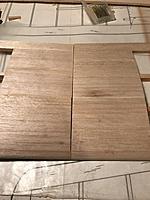 Views: 142
Views: 142
Testing the fit before gluing. -
Views: 145
The clapboard clamp. -
![Name: IMG_6697[1].jpg
Views: 151
Size: 821.1 KB
Description: The 72" wing is the biggest thing I've built on my bench. I don't have a place yet to store it.
The leading edge isn't actually wavy -- just an artifact of the panorama. Name: IMG_6697[1].jpg
Views: 151
Size: 821.1 KB
Description: The 72" wing is the biggest thing I've built on my bench. I don't have a place yet to store it.
The leading edge isn't actually wavy -- just an artifact of the panorama.](https://static.rcgroups.net/forums/attachments/6/2/0/3/5/7/t11047927-200-thumb-IMG_6697%5B1%5D.jpg?d=1530033805) Views: 151
Views: 151
The 72" wing is the biggest thing I've built on my bench. I don't have a place yet to store it. The leading edge isn't actually wavy -- just an artifact of the panorama.
-
 Views: 178
Views: 178
Pins inserted at an angle seem to do well at clamping the sheets tight to the spars. -
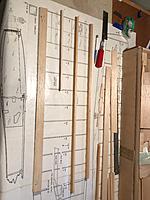 Views: 133
Views: 133
Moving on to the right wing. Laying out the spars. -
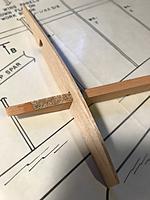 Views: 171
Views: 171
Custom-made sanding stick for deepening the cutouts and other detail sanding. -
Views: 127
Gluing on the wind tip blocks before shaping. -
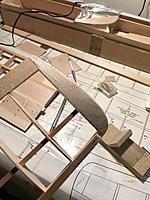 Views: 188
Views: 188
After shaping. The shaggy bit is where I glued on some 1/16 balsa because I over-sanded it. -
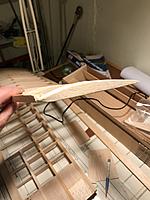 Views: 123
Views: 123
-
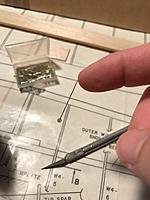 Views: 138
Views: 138
-
Views: 142
Tiny hands help with adding fillets of glue to the ribs. -
Views: 141
Pins holding everything in place while the glue dries. -
Views: 145
-
Views: 141
Raising the outer wing panel to the correct angle for the polyhedral. Clamps hold the tips spar tight against the main spar. -
 Views: 148
Views: 148
Sheeting added to the top.
